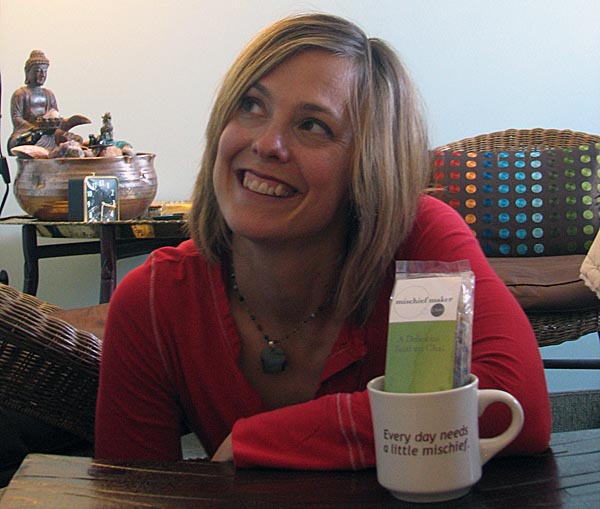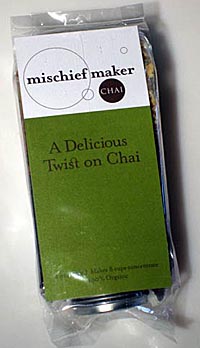
While trekking across the foothills of Mount Everest, Tara Huie — proprietor of Mischief Maker Chai — developed a taste for spicy tea. “It became associated with resting, which is always good when you are hiking, and with meeting people,” she explains one afternoon, as she tips a package of loamy looking tea and spices into a pot of honey and water and sets it to boil.
During the Himalayan trek, Huie and her fellow travelers slowly climbed to the 2,000 feet base camp, which is 17, 500 feet above sea level. Each day, they stopped in small villages of four or five homes, where as guests they were treated to a communal meal with local families. “The chai became a welcoming experience. The tea would arrive and we would have not only the chance to relax with each other, but also to talk with the people who had just served us –– it was very interactive, there was no ‘oh, don’t bother the guests.’”
On returning home, Huie found that while chai was very nearly ubiquitous in the coffee houses of America, it was also very different from the tea she’d enjoyed in Nepal. Here most chai is either the corn-syrup sweet and rather bland chai tea latte of Starbucks or its independent cafe cousin, whose flavor is often dominated by clove, astringent and tongue-numbing.
So Huie, a shiatsu anma practitioner and yoga instructor by trade, decided to start experimenting with spices. “In Nepal, the chai was very flavorful, but I could never quite distinguish one individual spice,” Tara says. “So, I started out playing with ratios, trying to find that synergy, that overall flavor.”
Chai’s origins are in Southern Asia, where chai means plain tea (we take our meaning from the Indian masala chai, which means tea with spices). Several sources say that it is the love child of a 5,000-year-old Hindu ayurvedic tradition, in which herbs and spices are used in decoctions for medicinal purposes, and the English habit of drinking tea with cream and sugar, introduced to India in the early 1900s when Great Britain began importing the bulk of its tea from Assam.
Traditional chai is made variously with a blend of black tea, cardamom, cinnamon, ginger, cloves, and pepper — the latter three contribute much of its medicinal properties. “In Chinese medicine, digestion requires heat,” explains Huie. “So, where coffee cuts the appetite and makes you acidic, the pepper, ginger, and cloves in chai create heat, expanding digestive potential.”

By now, the tea has reached a boil, and Huie sets a timer for 10 minutes. Our tea is simmering in water, but Huie’s early chais were steeped in milk because she wanted the more subtle flavors of the tea — nutty coriander and sweet, pungent cardamom — to have a presence. “I always knew that fat was flavor, but until I started brewing chai, I didn’t understand how much it allows flavor to exist,” she says. “You can’t really taste the coriander and cardamom unless you have fat in there; it binds the flavors together. That’s why chai in skim milk doesn’t taste as good as two percent — and nothing is better than whole milk, period.”
“Once I figured that piece out, it all kind of came together,” she adds.
After much experimentation, Huie created a chai that she enjoyed drinking and, perhaps better yet, serving to friends and guests. “If people enjoy it as much as I do, it fulfills – well, a need is a strong word – maybe, a place,” she says, as she removes the chai from the stove, and sets it on a back burner to cool for 10 minutes before straining. “Whether it’s the spices or the warmth they are craving, chai is very satisfying to people, so that becomes very satisfying for me, too.”
Huie, a self-proclaimed entrepreneur, pretty quickly realized that she had an unusual chai and that, if her friends and family loved it, others might also. A long time regular at Anodyne Coffee House in Kingfield, she approached the café’s owner, Theresa Lien, who told her to bring in some samples.
“We put some samples on the counter and that went really well,” says Lien. “So then we had to figure out how we could make it at the counter — that was sort of an issue. Tara was boiling and steeping small batches in milk, but that wouldn’t work at the counter. We needed to be able to make it to order and to use any kind of milk.”
And there were other technical challenges. If Huie made the tea in larger batches, they needed to be stored in a refrigerator, where the cold milk made the chai’s tannins, clove, and cinnamon more expressed and created noticeable inconsistencies in flavor. She needed to create a concentrate that could stand up to the cold and everything from soymilk to stevia sweetners.
In the end, Huie worked with Lien to create a chai that could be boiled and steeped in water. In order to preserve the balance of coriander and cardamom, she invented a spice blend aptly named “Additional Mischief,” which is sold in a separate packet with her tea. “It makes the chai a little bit more snappy,” Huie explains, as she dumps a generous spoonful in each of our cups, now full of chai and soymilk. “Basically, water brings out the cinnamon, cloves, and ginger too strongly. With the Additional Mischief, I’m putting back what’s missing — what’s missing from a lot of chais, I think.”
 And that, Lien says, is what gives Huie’s chai a steady following at Anodyne: “With Tara’s chai, the spices come out and that’s the overall flavor you are left with — not just sweet. She uses a quality black tea, too, so the caffeine kick is nice, too. People here appreciate that she uses organic spices, that’s important to them and the fact that it’s made locally is huge.”
And that, Lien says, is what gives Huie’s chai a steady following at Anodyne: “With Tara’s chai, the spices come out and that’s the overall flavor you are left with — not just sweet. She uses a quality black tea, too, so the caffeine kick is nice, too. People here appreciate that she uses organic spices, that’s important to them and the fact that it’s made locally is huge.”
The magic of Mischief Maker Chai is its balance. Behind the intangible spices is the malty, slightly astringent flavor of Assam tea and the flowery sweetness of honey. After 20 minutes of steeping, it really does have a substantially bigger buzz than your average cup of tea. But does it taste like Nepal? “It’s funny, after all that, if I went back to Nepal, I probably wouldn’t recognize the flavor,” laughs Huie, “I’m pretty sure mine is hotter — I think add more pepper than they ever did.”
Other than Anodyne, Mischief Maker Chai is available at Lucia’s Take Out, The Wedge Coop, and Yum. For Lucia’s, Huie created a special blend of chai that includes the extra tang of Szechuan red peppercorns. In the high chai season, Huie and her mother — the only employee in the chai empire, so far — are bagging tea every other month in the basement of the Greek Orthodox Church on Lake Calhoun. “Chai is still a big winter drink,” says Huie, “but it’s good cold with a little additional Additional Mischief. I’m thinking about making a chai popsicle — or maybe a push-up!”
And there’s a rooibos-based chai in the works for people who can’t abide caffeine.
But today, the afternoon light is fading fast, there’s a chill in the air, and the warm, spicy tea is comforting and somehow just right. “See, sitting here, drinking this,” Huie says, “I have that aah, chai feeling. You know, that new friend feeling.”

Full disclosure: I am totally biased when it comes to Mischief Maker Chai.
It is the only chai I’ll drink. I agree that many people associate chai with the syrupy-sweet, weak-tea version that is prevalent in many coffee shops, which I can’t drink. However, Mischief Maker Chai has such a deeper flavor, that it’s almost in a class by itself. I’ve had to force it on my friends, sometimes, to get them to try it. Always a surprise. Always a hit.
I am really glad Anodyne decided to offer it. I love it when local coffee shops offer local products and what could be better than the Anodyne/Mischief Maker combo!
Plus, I am crazy about adding “additional mischief” to my chai (and my life)!
Tara’s chai is the best I’ve had! Yum!